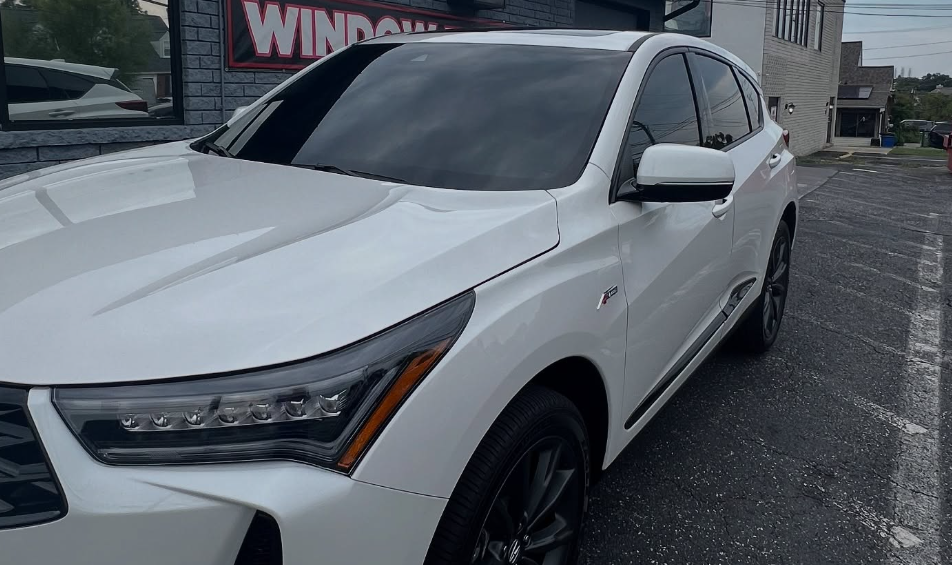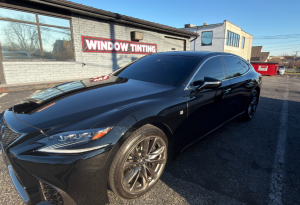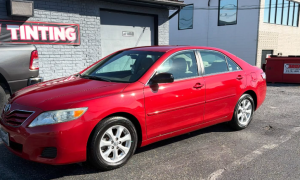Autumn is beautiful — the colors, the crisp air, the pumpkin spice — but those picturesque leaves have a nasty side hustle: they can wreck your car’s finish. A pile of leaves lying on a hood or windshield is more than just unsightly; it’s a chemical and physical threat to paint, trim, glass, and even drainage channels. Below is a clear, practical guide to what leaves do to your car, why that damage happens, and how a professional ceramic coating (plus a little seasonal care) protects your ride.
What leaves actually do to your car
At first glance, a leaf is harmless. But left in place for hours or days, leaves turn into a concentrated problem:
- They trap moisture. Wet leaves act like a sponge. Sitting on paint, they keep moisture against the clear coat and paint longer than you’d expect, which promotes oxidation and can accelerate corrosion where chips already exist.
- They release acids and tannins. As leaves decompose they leach tannins and organic acids. These substances can chemically etch and stain paint and trim—especially on lighter-colored surfaces—leaving dull, brownish marks that aren’t easily removed with a quick rinse.
- They hold contaminants. Leaves pick up pollen, sap, dirt and even industrial fallout. Placed against paint, those contaminants embed in the clear coat and make cleaning harder. Sap and bird droppings combined with leaf moisture are especially aggressive.
- They promote mold and mildew. Damp leaves on carpets and floor mats (think when you open the trunk or slide a wet wreath onto a seat) create the right environment for mildew and odor-producing microbes.
- They clog drains and channels. Leaves accumulate in cowl areas, sunroof drains, and gutter channels. That can cause blocked drainage, water leaks into the cabin, and accelerated rust in hidden spots.
- They abrade during removal. If leaves have baked on or dried into sticky residue, aggressive scraping or using the wrong brush can introduce micro-scratches and swirl marks in the clear coat.
Signs your car has leaf damage
- Brown, tannin-like stains on paint or trim that don’t wash off easily
- Oxidized, matte-looking patches where leaves sat for days
- Musty odors or mildew in carpets or trunk liners
- Blocked cowl drains or water pooled on the passenger floor after rain
- Sticky residues around windshield wipers or on glass that smear when you try to wipe them
If you see these signs, acting quickly reduces long-term repair costs.
How ceramic coating helps — what it does and what it doesn’t
Ceramic coatings are not magic, but they are highly effective when used properly. Here’s how they help protect your car from leaf-related damage — and a few realistic limits to keep in mind.
How ceramic coatings protect
- Hydrophobic surface: Ceramic coatings make surfaces extremely water-repellent. Water and leaf moisture bead up and roll off, reducing the time moisture sits on the paint and lowering the risk of oxidation and tannin staining.
- Chemical resistance: Coatings create a barrier that resists acids and organic contaminants from bonding directly to the clear coat. That makes it easier to remove leaf residue before it etches.
- UV protection: Ceramic coatings include UV inhibitors that slow the oxidation of the clear coat, keeping paint from fading and becoming more vulnerable to chemical staining.
- Ease of cleaning: Because contaminants don’t bond as tightly to coated surfaces, leaf stains, sap and grime are simpler to remove with a gentle wash — no heavy polishing required in most cases.
- Gloss and sacrificial layer: While coatings enhance gloss and clarity, they also act as a sacrificial surface for minor contaminants. It’s far easier to maintain a coated finish than to restore a neglected, etched one.
What ceramic coatings won’t do
- They won’t stop mechanical damage. Ceramic coatings don’t prevent stone chips, deep scratches, or dings. For chip protection, Paint Protection Film (PPF) is the appropriate solution.
- They’re not invulnerable to neglect. Coatings reduce the risk and make maintenance easier — but letting contaminated leaves bake on for weeks can still cause staining that requires professional correction.
- Improper installation reduces benefit. Coatings must be applied over a properly prepped, decontaminated, and corrected surface to perform as advertised.
Practical seasonal routine: what to do when leaves fall
- Remove leaves promptly. Don’t let piles sit overnight. Use a soft brush or gloved hand — avoid metal scrapers or stiff brushes that can scratch.
- Rinse the cowl and drains. Periodically check and clear the cowl area and sunroof drains so water runs away from the cabin.
- Wash with pH-neutral soap. After leaf exposure, a gentle wash removes organic residues without stripping ceramic topcoats.
- Address sap and stubborn stains quickly. Use an appropriate tar/adhesive remover or have a pro treat the area — the longer it sits, the harder it is to remove without polishing.
- Consider targeted PPF for high-risk areas. If you park under trees frequently, a front-end PPF package or hood edge film reduces the risk of chips and stained leading edges.
- Schedule a professional inspection and maintenance. If you have ceramic coating, a seasonal top-up or inspection helps maintain hydrophobic performance and warranty compliance.
When to call the pros (and why it’s worth it)
- If stains or etching don’t come off with a gentle wash
- When there’s a recurring mildew or musty smell in the cabin
- If cowl drains are blocked or you notice water leaks into the floor pans
- If you want a long-term solution: professional ceramic coating plus targeted PPF offers the best defense against seasonal leaf fallout, sap and salty roads
Professional detailers provide the prep, products, and controlled environment that maximize the performance of ceramic coatings — and they’ll correct existing contaminants before bonding a coating to the paint.
Bottom line
Leaves are more than a quaint sign of fall — they’re a slow-moving threat to your vehicle’s finish and health. Ceramic coatings aren’t invincible, but when professionally applied and properly maintained they dramatically reduce the damage leaves and fall moisture can cause. Combine timely leaf removal, thoughtful washing, and seasonal professional maintenance (plus PPF where needed) and your car will thank you with a finish that holds its gloss and resale value year after year.
If you’d like a fall protection plan tailored to your driving habits — from a front-end PPF package to a System X ceramic coating and seasonal maintenance — contact Ideal Image Auto Salon. We’ll inspect your vehicle, recommend the right protection, and schedule the work so your car stays clean, glossy, and worry-free through leaf season.
Ideal Image Auto Salon
7901 Belair Rd, Nottingham, MD 21236
Phone: (410) 663-8468





